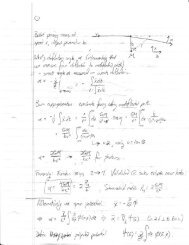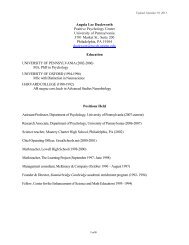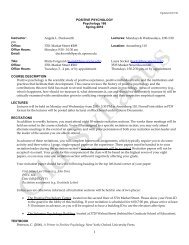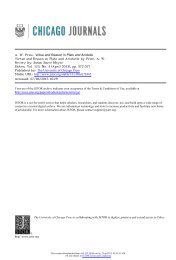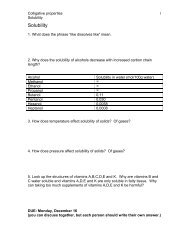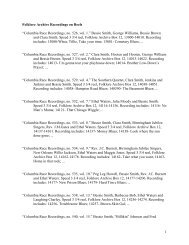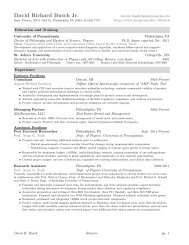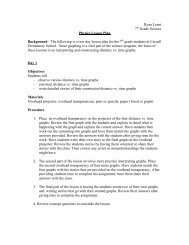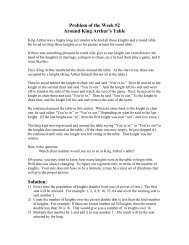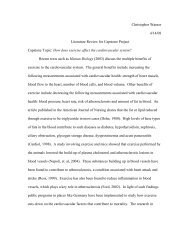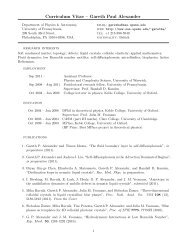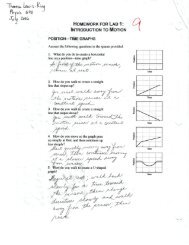Dusty Carroll Lesson Plan 4: Getting to know Lactase Background ...
Dusty Carroll Lesson Plan 4: Getting to know Lactase Background ...
Dusty Carroll Lesson Plan 4: Getting to know Lactase Background ...
You also want an ePaper? Increase the reach of your titles
YUMPU automatically turns print PDFs into web optimized ePapers that Google loves.
In other words, lactase acts as a catalyst for the hydrolysis of the O-galac<strong>to</strong>sidic bond in the sugar, lac<strong>to</strong>se.<br />
The exact mechanism of the reaction has been studied and Juers, Heightman, et.al. have summarized<br />
previous work and given clarification <strong>to</strong> the proposed mechanism. (9) <strong>Lactase</strong>, aka β-galac<strong>to</strong>sidase,<br />
hydrolyzes its substrate (lac<strong>to</strong>se) while allowing the constituent monosaccharides <strong>to</strong> keep their<br />
stereochemistry. The reaction is a two step reaction. The first step is cleavage of the glycosidic bond.<br />
HO<br />
HO<br />
H<br />
OH<br />
H<br />
H<br />
H<br />
O<br />
O<br />
O<br />
OH<br />
C<br />
H<br />
H<br />
Glu 537<br />
Glu 461<br />
C<br />
O –<br />
O<br />
O<br />
HO<br />
OH<br />
OH<br />
H<br />
H<br />
H<br />
O<br />
OH<br />
H<br />
OH<br />
HO<br />
HO<br />
H<br />
OH<br />
H<br />
H<br />
H<br />
O<br />
O<br />
O<br />
OH<br />
C<br />
H<br />
Glu 537<br />
Glu 461<br />
C<br />
H<br />
O<br />
O<br />
O<br />
HO<br />
OH<br />
OH<br />
It is believed that this process takes place with a mechanism somewhere between that of an SN1 and that<br />
of an SN2. The Glu537 from the active site of the enzyme acts as a nucleophile <strong>to</strong>ward the anomeric<br />
carbon of the galac<strong>to</strong>syl group. This forms an intermediate with enzyme Glu537 in the alpha-glycosidic<br />
orientation. As seen in the above reaction, this is facilitated by a concerted pro<strong>to</strong>nation of the glycosidic<br />
oxygen. This particular step is not well-proven, yet, but it is one explanation. The acid responsible for<br />
pro<strong>to</strong>nation may be the Glu461 from the active site<br />
of the enzyme.<br />
Functional Amino Acid Residues within <strong>Lactase</strong><br />
Glutamic acid: In its anionic state (like Glu537), this acts<br />
as a nucleophile. In its neutral state (like Glu461), it acts<br />
as an acid and donates a pro<strong>to</strong>n as described in the text.<br />
H 2N CH C<br />
CH 2<br />
CH 2<br />
C<br />
OH<br />
Tyrosine: The –OH group on the side chain participates<br />
in hydrogen bonding in order <strong>to</strong> stabilize the transition<br />
state.<br />
O<br />
O<br />
O<br />
OH<br />
H<br />
H<br />
H<br />
O<br />
OH<br />
H<br />
OH<br />
HO<br />
HO<br />
H<br />
OH<br />
H<br />
H<br />
O<br />
H<br />
C<br />
O<br />
O<br />
OH<br />
Glu 537<br />
O<br />
Glu 461<br />
C<br />
O<br />
H<br />
O<br />
HO<br />
OH OH<br />
The second step is the transfer of the galac<strong>to</strong>syl<br />
product from the nucleophile of the enzyme<br />
(Glu537) <strong>to</strong> an accep<strong>to</strong>r molecule. This step is<br />
believed <strong>to</strong> occur in an SN1 release of the<br />
nucleophile. During this process, the carbocation<br />
(oxocarbenium ion) transition state is thought <strong>to</strong> be<br />
stabilized by interactions between Glu537, Tyr503<br />
and the oxygen on the galac<strong>to</strong>syl ring. Glu461<br />
abstracts a pro<strong>to</strong>n from the accep<strong>to</strong>r molecule,<br />
allowing the accep<strong>to</strong>r molecule <strong>to</strong> act as a<br />
nucleophile <strong>to</strong>ward the oxocarbenium ion.<br />
There is some debate as <strong>to</strong> whether the metal<br />
H2N CH<br />
CH2 C OH<br />
ligands in the active site play a role in the catalysis.<br />
They appear <strong>to</strong> facilitate the catalysis, but the exact<br />
mechanism for this is not yet determined. The<br />
major metal ion ligands found in the enzyme are<br />
OH<br />
magnesium and either sodium or potassium ions.<br />
An alternate theory of mechanism for the first step<br />
of this reaction involves magnesium forming a complex by direct electrophilic attack on the glycosidic<br />
oxygen. This reaction will not be further discussed, but it is important <strong>to</strong> realize that there are still several<br />
possibilities for showing the actual reaction mechanism for this catalysis.<br />
Catalytic Function<br />
Catalytic efficiency values are altered by pH and also by the absence of magnesium for the lactase<br />
enzyme. (9) Though the mechanism through which magnesium ion works is not clear, it appears that its<br />
H<br />
H<br />
H<br />
O<br />
OH<br />
H<br />
OH



